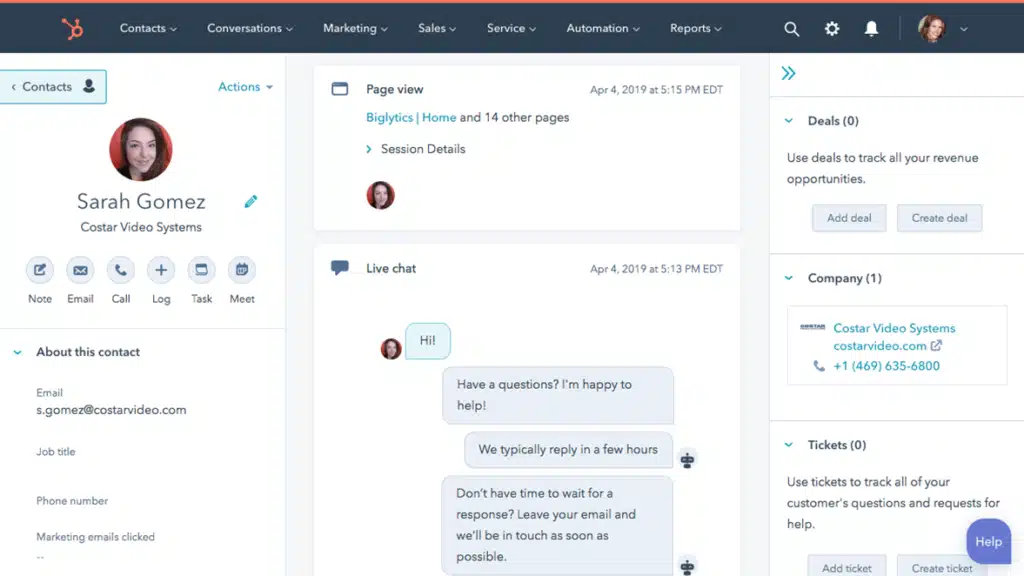Do I really need to introduce you to Hubspot? Hubspot is THE premier platform for inbound marketing, sales, and CRM in the market. They describe it better than I can on their website: it’s the SaaS platform that brings together the essential tools to connect your marketing, sales, and customer service activities around the customer.
While Hubspot is widely recognized by marketers for its inbound marketing capabilities, I must admit it’s less renowned in the eCommerce realm.
During my assignment for a DNVB that manufactures and distributes eco-friendly yoga clothing in B2C, I notably implemented Hubspot and managed its integration with Shopify.
Every time I mention this experience, I get the comment, “What? You used Hubspot for a B2C eCommerce site? Isn’t it more for B2B?”
Yet, indeed, Hubspot is entirely applicable to B2C eCommerce; let me give you a brief overview.
Enjoy a 360 customer view
By integrating Hubspot with your B2C eCommerce platform, you can build a comprehensive 360° view of your customers. Your prospects and clients interact with your brand through various touchpoints: your advertisements, your eCommerce site, your customer service, and more.
This is where a CRM like Hubspot truly shines: it centralizes all your prospect and customer data within the platform. Your marketing, sales, and customer service teams all have access to this centralized data. So, when a customer sends you an email or calls customer service, you have all the information you need about that customer at your fingertips.
- Their personal information,
- The pages of the site they’ve visited in the past,
- The products they’ve viewed and purchased,
- The interactions they’ve had with you (chat, email, etc.).

Customize your sales funnel
If Hubspot is so renowned for B2B, it’s because it offers a sales funnel that perfectly aligns with B2B sales. By default, the sales stages set up in Hubspot are:
- Scheduled Meeting,
- Qualified Prospect,
- Presentation Scheduled,
- Decision Maker Engaged,
- Contract Sent,
- Contract Signed,
- Contract Lost.
However, these stages are 100% customizable, and it’s entirely possible to tailor them to B2C eCommerce. For instance, we can set up:
- Step 1. Unknown Visitor: A visitor clicks on one of your advertisements and lands on a page of your B2C site. They then exit your site.
- Step 2. Engaged Visitor: When this visitor starts browsing a product page and adds the product to their cart, they are moved to the “Engaged Visitor” stage. This prospect is presumably warmer than others.
- Step 3. Qualified Visitor: At this stage, we still don’t have the personal information of the contact, which is critical for reaching out through your marketing activities. If the contact initiates the checkout process and creates an account, we can then gather their personal details. We can also collect their email through newsletter sign-ups, chat interactions, or by them downloading a free guide, for instance.
- Step 4. New Customer: Thanks to Step 3, we can activate automated digital marketing actions to convert the prospect into a customer. As soon as they make their first purchase, they will be identified in your database as a new customer.
- Step 5. Engaged Customer: A new customer who makes subsequent purchases will be categorized as an engaged customer.
- Step 6. VIP Customer: You can set a purchase threshold (either by order count or total amount) beyond which a customer is designated as VIP. You can then identify and treat these customers in a special manner.
- Step 7. Dormant Customer: Lastly, a customer who hasn’t made a purchase for a specified period can be categorized as a dormant customer and approached differently.
Once your sales funnel is customized to fit your B2C eCommerce activity, the Hubspot platform takes on a whole new significance, enabling you to automate your digital marketing and monitor your performance indicators.
Automate Your Digital Marketing
Hubspot’s Marketing Hub provides all the necessary features to activate your digital marketing in an automated manner and “push your customers” from one stage to the next in your sales funnel:
- Create a welcome email after a first purchase,
- Automatically send an email for abandoned carts,
- Send emails to generate additional sales.
How to integrate Hubspot to your eCommerce platform?
Whether it’s natively or through specific connectors, Hubspot integrates seamlessly with all the major platforms on the market:
- Prestashop
- Shopify
- Magento
- WooCommerce
- BigCommerce
- …
Use the connectors available on the marketplace and discuss with your developer or integrator.
Conclusion
I hope I’ve convinced you that Hubspot pairs wonderfully with B2C eCommerce, just as it does with sales or B2B eCommerce.
For sure, there are many CRM and email marketing platforms available on the market. As always, make sure you list your use cases and functional needs before you choose a platform.
